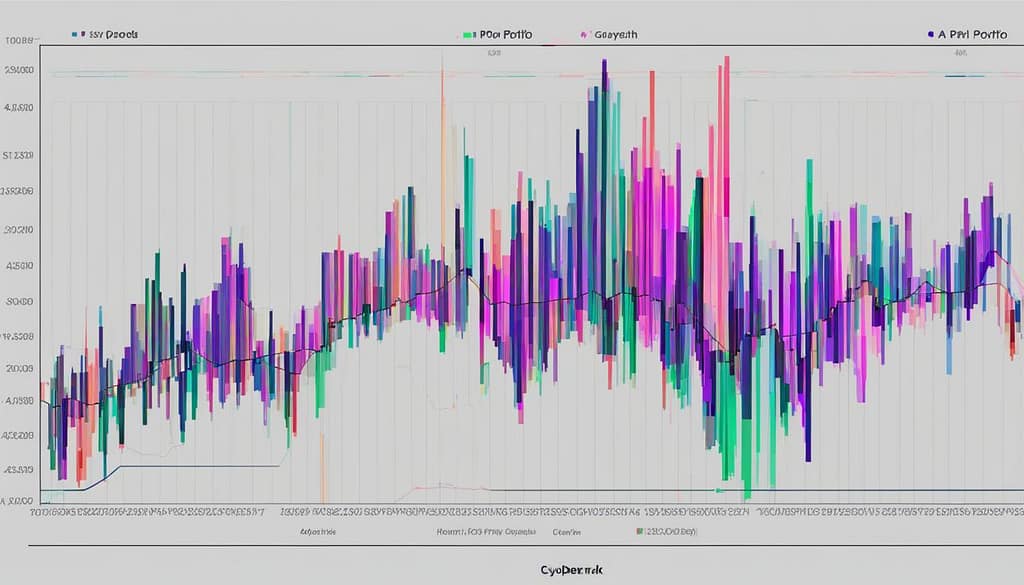Enhancing Portfolio Diversification with Cryptocurrency
The advent of cryptocurrencies, spearheaded by household names such as Bitcoin, Ethereum, and Binance Coin, has dramatically redefined the contours of Portfolio Management and Investment Strategy. For Canadian investors eyeing prudent Portfolio Diversification, these digital currencies emerge as a compelling asset class. In the ever-shifting landscape of investments, the strategic inclusion of cryptocurrencies could play a pivotal role in enhancing returns while potentially tempering the risk profile of a diverse portfolio.
Amidst an environment where established asset classes like Forex Markets, Gold, Corporate Bonds, Real Estate, and major equity indices navigate through their complexities, cryptocurrencies serve to inaugurate an era of uncorrelated investment opportunities. A deeper dive into mean-variance optimization and other Portfolio Management methodologies is shedding light on how cryptocurrencies are not merely a trend but a substantive investment avenue for risk-adjusted returns in today’s market.
Key Takeaways
- Understanding the disruptive potential of cryptocurrencies on traditional Portfolio Diversification strategies.
- Exploring the unique attributes of digital assets contributing to the optimization of risk-adjusted returns.
- Assessing strategic asset allocation models that keenly integrate cryptocurrencies within diversified portfolios.
- Reviewing empirical research on correlations between cryptocurrencies and different asset classes like S&P 500 and Mid Equity Market.
- Analyzing how the volatile nature of the cryptocurrency market can affect Portfolio Management decisions.
- Considering the broader implications of emerging digital currencies in reshaping investment strategies in Canada.
Understanding the Role of Cryptocurrencies in Modern Investment Strategy
As investments diversify into the digital realm, cryptocurrencies emerge as a powerhouse, consistently redefining the fabric of Portfolio Management and investment strategies. Canadian investors are now looking beyond the traditional portfolio models, curious about the burgeoning impact of digital assets.
The Evolution and Growth of Digital Assets
The transformation of cryptocurrencies from an obscure concept to vital components of sophisticated investment portfolios underscores their seismic impact on the global financial landscape. At the fortitude of this innovation are features such as decentralization, facilitated by breakthrough blockchain technology. This core trait eschews the need for a central authority, presenting a radical departure from conventional financial frameworks. Notably, the market capitalization of cryptocurrencies has soared, with industry titans like Bitcoin reaching monumental valuations.
Key Characteristics of Cryptocurrencies Affecting Portfolio Management
The nuances of managing digital wealth are shaped by distinctive attributes of cryptocurrencies. Market inefficiency, a stark contrast to established markets’ predictive nature, beckons innovative approaches to investment strategy. Volatility, while often cited as a deterrent, adds a dynamic layer to the calculus of risk and potential return. Besides, the organic mechanisms influencing supply – from Bitcoin’s halving to Ethereum’s shift to proof-of-stake – further define the strategic deployment of digital assets within investment portfolios.
Canada’s forward-thinking investors are continually adapting, acknowledging the transformative potential of cryptocurrencies, not just as speculative instruments, but as strategic tools in diversifying and buttressing investment frameworks for the digital age.
Exploring Cryptocurrency’s Low Correlation with Traditional Markets
The realm of investment has long been dominated by traditional markets, but with the advent of cryptocurrencies, a new frontier of portfolio diversification has emerged. Their distinctive behaviour during periods of market turbulence calls for deeper analysis and considerations within any savvy investment strategy.
Studies Showcasing Cryptocurrency’s Unique Market Behavior
Several empirical studies have put cryptocurrencies under the microscope, observing their interaction with the conventional financial system. The findings consistently point towards an inarguable trait of cryptocurrencies – their low correlation with traditional markets such as equities and commodities. This peculiarity establishes them as an asset class with enduring potential for diversification.
The Impact of Market Turbulence on Cryptocurrency Correlations
While the correlation between cryptocurrencies and traditional asset classes is typically low, this link tends to strengthen during times of economic uncertainty or market shocks. Events like the Brexit referendum have led to noticeable shifts in market dynamics, prompting cryptocurrencies to behave more akin to traditional safe-havens, albeit temporarily. Acknowledging the fluid nature of cryptocurrency correlation is imperative for constructing an effective investment strategy.
| Event | Traditional Market Response | Cryptocurrency Market Response | Correlation Change |
|---|---|---|---|
| Brexit Referendum | Increased volatility in GBP and Euro markets | Heightened interest and inflow into cryptocurrencies | Moderate Increase |
| Coincheck Hack | Minimal impact on traditional markets | Significant downturn in cryptocurrency prices | Temporary Increase |
| Global Financial Crisis | Equities and bonds suffered losses | Stable cryptocurrency market with independent movements | Low Correlation |
These insights espouse cryptocurrency’s position in the modern investment arena, underscoring the necessity of including digital assets in a comprehensive investment strategy. As market landscapes evolve, so too does the role of cryptocurrencies, beckoning investors to constantly refine their approach to maintain an edge in the face of market turbulence.
Asset Allocation Strategies: Incorporating Cryptos into Your Investment Mix
Within the vast landscape of investment strategies, the integration of cryptocurrencies into an investment mix has emerged as a modern approach towards achieving comprehensive portfolio diversification. Asset allocation, a cornerstone of investment management, has traditionally been focused on finding the optimal balance between stocks, bonds, and other asset classes. However, as the financial ecosystem evolves, the allure of cryptocurrencies as a diversification tool cannot be ignored.
The potential of cryptocurrencies to provide high risk-adjusted returns is being evaluated, with strategies adjusting the traditional asset model to include this new asset class. The inclusion of digital assets such as Bitcoin, Ethereum, and others into asset allocation models is inviting discussions among savvy investors looking to elevate their portfolio performance.
As the interplay between cryptocurrencies and traditional financial markets grows, investors are keenly observing the trends to harness conditional diversification benefits and time-varying advantages.
- Understanding the inherent volatility and market dynamics of cryptocurrencies
- Considering a modest percentage of digital assets to complement traditional holdings
- Adopting advanced optimization techniques for crypto-inclusive portfolio design
Fostering a nuanced understanding of investment mix dynamics, financial experts endorse the exploration of cryptocurrencies beyond iconic Bitcoin. Diverse portfolios incorporating lesser-known but rapidly advancing digital currencies like Ripple, Cardano, or Polkadot have shown promise in recent analyses.
- Allocation to a range of cryptocurrencies for improved return profiles
- Strategic weighting of digital asset classes to match investor risk appetites
- Advanced monitoring and rebalancing to navigate the volatile crypto markets
Overall, the shift towards incorporating cryptocurrencies into asset allocation plans represents a significant step forward in investing. It prompts a closer look at modern strategies that can embrace the digital age and optimize investment outcomes for Canadians.
The Historical Performance of Cryptocurrencies in Diversified Portfolios
The advent of cryptocurrencies has undeniably altered the financial landscape, offering unique instruments for investors. A closer look at the historical performance of these digital assets in diversified portfolios uncovers crucial data for future investment decisions. It is imperative to consider the past returns and volatility of cryptocurrencies when assessing their role and impact within a diversified investment strategy.
Analyzing Past Returns and Volatility of Digital Assets
Investors have turned their focus on the intriguing long-term performance and the idiosyncratic price movements of cryptocurrencies. Historical data points to a trend of long memory and heteroscedasticity in these assets, which is indicative of their fluctuating nature. Noteworthy is the tendency for surges in cryptocurrency value followed by equally dynamic corrections, which both weigh heavily on portfolio management.
An analytical view into the historical performance reveals that, despite occasional sharp downturns, cryptocurrencies have displayed substantial resilience and a propensity for recovery, delivering noteworthy returns over time. Given their uncorrelated nature with traditional asset classes, they have often provided much-needed buoyancy to diversified portfolios during market downturns.
Comparing Traditional and Crypto-Enhanced Portfolio Outcomes
Studies comparing traditional portfolios with those containing a mix of cryptocurrencies have illuminated the impact of digital assets on overall portfolio performance. A diversified approach, which involves allocating investments across a variety of cryptocurrencies, has often led to an improved performance profile, capable of both heightening returns and mitigating systemic risk.
The table below depicts a comparison of traditional and crypto-enhanced diversified portfolios. It evaluates the aggregate outcomes via key metrics that include average annual returns, volatility measures, and sharp ratios over a set historical period.
| Portfolio Type | Average Annual Return | Volatility (Standard Deviation) | Sharpe Ratio |
|---|---|---|---|
| Traditional Portfolio | 5% | 10% | 0.50 |
| Crypto-Enhanced Portfolio | 7% | 12% | 0.58 |
This summary suggests that the inclusion of digital assets—when effectively managed within diversified portfolios—can indeed elevate historical performance, featuring higher past returns relative to their increased volatility counterpart. Thus, the role of cryptocurrencies in modern investment portfolios is becoming more pronounced and indispensable to investors aiming to optimize their risk-adjusted returns.
In conclusion, the historical data fosters understanding that commitment to cryptocurrency diversification is not only about embracing the opportunities for appreciable gains but also about constructing robust portfolios that stand resilient in the face of market unpredictability. Canadian investors, and indeed the global cohort seeking diversified investment routes, are steadily recognizing that cryptocurrencies offer both challenges and opportunities in the realm of portfolio management.
Risks and Rewards of Adding Cryptocurrency to Investment Portfolios
The dynamic landscape of Investment Portfolios is witnessing a paradigm shift with the entry of cryptocurrencies, an asset class known for its exhilarating peaks and troughs. While the allure of high returns tempts many investors to consider Cryptocurrency as a viable component for Portfolio Diversification, it is imperative to navigate the waters of risks and rewards diligently.
One of the paramount benefits of adding cryptocurrencies to your portfolio is the prospect of considerable rewards. Despite their infamous volatility, when held over a longer term, these digital assets have been capable of producing substantial gains that can significantly uplift an investor’s portfolio value. However, the potential for high rewards comes hand-in-hand with substantial volatility, which underscores the importance of a balanced approach to asset allocation.
Portfolio Diversification with cryptocurrency can indeed reduce overall portfolio risk when correlations with traditional investments waver. However, the investment horizon and investment strategy’s alignment with individual financial goals remain pivotal. A strategic incline towards cryptocurrencies might entail adjusting risk appetites and ensuring proper risk management practices are in place.
| Risk Factor | Impact on Investment Portfolios | Risk Mitigation Strategies |
|---|---|---|
| Market Volatility | Increased potential for large gains and losses | Diversify holdings and incorporate fixed-income assets |
| Regulatory Changes | Possibility of adverse effects on the market value and liquidity | Stay updated with global financial regulations and compliance requirements |
| Technological Risks | Threats from hacking, software issues, or loss of digital wallet access | Implement robust security measures and backup systems |
| Adoption & Sentiment | Swayed by media, public opinion, and adoption by businesses | Perform sentiment analysis and trend monitoring |
As investors explore the Risks and Rewards of introducing Cryptocurrency to their Investment Portfolios, the importance of due diligence cannot be overstated. Empowering yourself with knowledge and leveraging expert insight can aid in crafting a diversified portfolio aligned not only with market opportunities but also with one’s risk tolerance and investment goals.
Portfolio Management: Balancing Cryptos with Stocks and Bonds
In today’s financial landscape, the art of Portfolio Management has grown to encompass an array of investment vehicles, including Cryptos, Stocks and Bonds. Investment Experts are tirelessly refining allocation strategies to ensure balanced, risk-adjusted portfolios that can withstand market fluctuations and capitalize on growth opportunities.
Optimal Cryptocurrency Allocations According to Investment Experts
With an eye on contemporary market trends, investment experts recommend a subtle yet strategic approach to the inclusion of cryptocurrencies. An allocation nearer to 5%, adjusted for individual risk tolerance and market conditions, seeks to leverage the unique position of cryptocurrencies, occupying a distinct space away from the volatility of traditional securities.
The optimal allocation balance hinges on the dual criteria of maximizing potential for returns while controlling for the inherent volatility of cryptos. This prudent allocation is designed not only to enhance portfolio growth but also to usher in a new dimension of diversification, serving as a hedge against inflation and market uncertainty.
Adapting Traditional Portfolio Theories to Include Digital Assets
As the investment environment evolves, so too must the theories that underpin Portfolio Management. Traditional models, once grounded exclusively in stocks and bonds, are being recalibrated to account for the rise of digital assets. This adaptation entails a strategic rethink, positioning cryptocurrencies as vital instruments capable of refining the risk-return profile of modern portfolios.
Incorporating cryptocurrencies into these long-established theories elevates the potential to tap into emerging sectors, foster resilience, and avoid over-concentration in any single asset class. As a result, investors reap the benefits of a Portfolio Management strategy that is both forward-looking and grounded in expert empirical insight.
Measuring the Impact of Cryptocurrency on Portfolio Diversification
The burgeoning role of cryptocurrency within the realm of financial investment has spurred a significant amount of research, particularly regarding its influence on portfolio diversification. Understanding this impact not only involves impact measurement techniques but also navigates through an environment of dynamic market conditions and investor risk perceptions.
Evaluating Diversification Benefits Using Statistical Methods
One of the hallmark techniques for quantifying the diversification benefits conferred by cryptocurrencies is the deployment of advanced statistical methods. Measures such as the Conditional Diversification Benefits (CDB) index provide critical insights, gauging how well cryptocurrency enhances the spread of risk within a portfolio. Similarly, mean-variance optimization is utilized to balance the expected returns against the inherent risks of portfolio assets, allowing investors to craft investment vehicles tailored to their risk tolerance and return expectations.
Cryptocurrency’s Role in Reducing Portfolio Risk
The core attribute of cryptocurrency that has captured the attention of investors aiming for robust portfolio diversification is its relatively low correlation with more traditional asset classes such as stocks, bonds, and commodities. This trait suggests that, by judicious inclusion of cryptocurrencies into investment portfolios, individuals can potentially mitigate portfolio risk. Nevertheless, it’s paramount for investors to acknowledge that the diversification benefits and their ability to lower portfolio risk are not static. As with any asset class, these benefits can ebb and flow with shifts in global economic landscapes and investor sentiment.
Indeed, the allure of cryptocurrency in reducing portfolio risk warrants a nuanced assessment of both potential rewards and the associated risks. By leveraging the measurable effects of cryptocurrency on portfolio diversification, investors are better equipped to strike a prudent balance, achieving a portfolio composition that resonates with their strategic investment horizon.
Advanced Portfolio Construction Techniques with Cryptocurrency
As the landscape of investment diversifies, the inclusion of digital assets in portfolio management has become an essential strategy in achieving higher financial efficiency. The dynamic nature of cryptocurrency markets necessitates sophisticated approaches in portfolio construction techniques to optimally balance rewards against risks. This section examines how mean-variance optimization and filtering historical simulations contribute to a more robust cryptocurrency portfolio strategy.
Mean-Variance Optimization in the Context of Crypto Inclusion
Mean-variance optimization, a foundational concept in modern portfolio theory, is evolving with the incorporation of cryptocurrencies. The strategy involves an analytical approach to constructing portfolios, wherein expected returns are maximized for a given level of risk by meticulously assessing portfolio variance and covariance. This optimization becomes particularly useful when considering the unpredictable volatility of cryptocurrencies.
Utilization of Filtration Historical Simulation for Risk Assessment
The Filtration Historical Simulation (FHS) model provides a more nuanced risk assessment in the domain of cryptocurrency inclusion. This advanced technique allows investors to forecast potential losses and to adjust strategy parameters, considering the non-linear and asymmetric behaviour of cryptocurrency markets.
| Crypto Asset | Expected Return | Variance | Value-at-Risk (VaR) |
|---|---|---|---|
| Bitcoin | 15% | 0.75 | 9% |
| Ethereum | 10% | 0.60 | 7% |
| Binance Coin | 12% | 0.50 | 6% |
The integration of Portfolio Construction Techniques that utilize both Mean-Variance Optimization and Risk Assessment methodologies such as FHS highlight the increasing maturity in the practice of Cryptocurrency Inclusion in investment portfolios. The steady march towards more complex investment strategies indicates a growing acceptance and the necessity to understand and manage these novel asset classes within the broader framework of portfolio diversification.
Future Trends: The Growing Institutional Adoption of Cryptocurrency
As the world of finance continues to evolve, institutional adoption of cryptocurrency is moving from speculative ventures to concrete investment strategies. The rise in institutional interest is not merely a trend but a pivotal shift that is expected to shape the trajectory of digital assets globally. Recognizing the magnitude of this change is essential for understanding the forthcoming landscape of investment opportunities.
Assessing Market Sentiments and Regulatory Developments
Institutional investors bring not only capital but also a demand for rigorous regulatory frameworks and enhanced market stability. The market sentiments have become increasingly positive as heavyweight financial players enter the crypto space. Comprehensive assessments of these sentiments, coupled with ongoing regulatory developments, underscore the growing legitimacy of cryptocurrencies as an asset class.
Implications of Institutional Interest on Portfolio Strategies
The onslaught of institutional interest in cryptocurrencies is not without its effects on individual investors. The strategic inclusion of digital assets within one’s portfolio may be influenced by the institutional market maneuvers, making it incumbent upon investors to stay informed and agile. Advanced approaches to portfolio management now often consider this burgeoning acceptance of cryptocurrency in diversified asset allocations.
| Year | Institutional Investment Volume (in billion USD) | Market Impact Analysis |
|---|---|---|
| 2020 | 5.5 | Moderate Increase in Crypto Prices |
| 2021 | 15.8 | High Price Volatility and Mainstream Acceptance |
| 2022 | 22.4 | Stabilization of Market Prices, Regulatory Clarity |
| 2023 | Estimated >30 | Increased Institutional Platforms and Financial Products |
The data presented in the table above highlights a consistent upsurge in institutional investment over recent years, signaling a reinforced confidence in cryptocurrency and suggesting a need for individual investors to recalibrate their market strategies in kind.
- Continuous monitoring of institutional investment patterns.
- Analysis of the evolving regulatory environment.
- Adapting personal investment strategies to reflect market developments.
The convergence of market sentiments and institutional adoption is rapidly defining the vanguard of investment futures. For savvy investors, keeping apace with these developments is not only prudent; it’s imperative.
Effective Risk Management for Crypto-Inclusive Investment Portfolios
Navigating the dynamic terrain of crypto-inclusive portfolios requires acute awareness of Risk Management principles. With the advent of digital assets, traditional Investment Strategy frameworks encounter novel complexities, prompting a reevaluation of Portfolio Diversification strategies. Investors are tasked with harnessing the high volatility that cryptocurrencies proffer, transforming potential risks into calculated advantages.
Adaptability and vigilance are key in managing an investment portfolio with cryptocurrency holdings. The first order of business is establishing a foundation of controlled exposure to these assets, as the capricious nature of the crypto market demands a disciplined approach. One must also keep abreast of market trends and regulatory changes, as they can have significant implications for portfolio performance.
The hallmark of prudent portfolio management in the context of crypto-assets lies in understanding and responding to market indicators. Here are the strategic pillars:
- Diligent tracking of performance metrics
- Detailed analysis of market conditions and volatility trends
- Alignment of the portfolio’s risk profile with investment goals
An investor’s proactive stance on volatility can mean the difference between fortuitous gains and steep losses. Thus, identifying the optimal diversification level is paramount and requires continual adjustment to maintain alignment with evolving financial market correlations.
Below is a visual representation of how incorporating cryptocurrencies can modify portfolio risk parameters:
| Aspect of Risk Management | Traditional Portfolio | Crypto-Inclusive Portfolio |
|---|---|---|
| Exposure Limits | Based on established asset classes | Adaptative to crypto market fluctuations |
| Variance Analysis | Considers correlation against common indices | Includes non-traditional volatility metrics |
| Risk Mitigation Tools | Primarily diversification and hedging | Expands to include crypto-specific strategies |
The integration of cryptocurrencies in an investment portfolio should be finely tuned to an investor’s capacity to absorb risk, aiming for longevity and sustainability of returns. Expert investors recognize the transformative impact of cryptographic assets and incorporate them as a bespoke element of their broader investment strategy, tailored to their unique financial narrative and risk tolerance.
As the investment landscape evolves with the assimilation of digital currencies, strategic risk management becomes the cornerstone for securing a robust and forward-looking portfolio. The ultimate objective is to foster a balanced portfolio that can withstand the ebb and flow of market tides, steadfast in the pursuit of long-term investment success.
Conclusion
In the evolving landscape of Investment Strategy, the integration of Cryptocurrency has introduced a dynamic edge to traditional concepts of Portfolio Diversification. Although not without its challenges, the strategic inclusion of these digital assets continues to be a subject of keen interest within the realm of Portfolio Management. By effectively leveraging the diversification benefits, investors stand to gain enhanced returns while simultaneously dispersing risks associated with individual asset classes.
As the dialogue on investment strategies matures, it embraces the complexities that cryptocurrencies bring to the table. The market’s fluid nature and ongoing regulatory shifts call for a balanced, well-informed approach – one that recognizes the value and intricacies of cryptocurrencies in a broader investment context. This awareness and adaptability are essential for investors inclined to push the envelope of traditional portfolio construction.
Leading into the future, the foresight to blend these novel digital assets with conventional investments could be pivotal for achieving robust, diversified portfolios. The onus falls on investors to remain vigilant, learning about the ever-changing features of cryptocurrencies and assessing how they align with personal financial objectives. Ultimately, the symbiotic integration of innovation and traditional investments may be the cornerstone of forward-thinking, diversified wealth management strategies.










